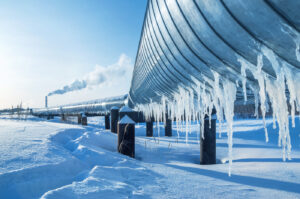
When designing fastening systems, it is essential to consider the environmental conditions in which they will be used. These factors can be critical on their own, regardless of the application or the receiving materials. Temperature, in particular, has a significant impact on the performance and durability of fasteners.
The Importance of Temperature in Fastening Systems
In the article Fasteners for High-Temperature Applications, we have already explored how exposure to high temperatures can lead to thermal expansion, relaxation, and creep in metallic materials, compromising their integrity.
However, cold temperatures also present unique challenges. Sub-zero conditions can reduce ductility, impact resistance, and structural stability, making it crucial to select materials and treatments that ensure reliability even in the most extreme environments.
Challenges of Fastening Systems in Low-Temperature Conditions
When temperatures drop below 0°C, fastener materials undergo significant transformations, which can negatively impact safety and joint performance. Some of the main challenges include:
1. Ductile-to-Brittle Transition
Many metallic materials undergo structural changes when exposed to low temperatures. This phenomenon, known as the Ductile-to-Brittle Transition Temperature (DBTT), causes the material to lose elasticity and become more prone to brittle fracture under load.
For example, Grade 2 carbon steel is unsuitable for sub-zero applications as it becomes excessively fragile. To prevent sudden breakages, it is essential to select materials with a low DBTT, such as austenitic stainless steels with high nickel content.
2. Thermal Contraction and Loss of Preload
At very low temperatures, materials contract due to thermal shrinkage. This can affect fastener stability, leading to:
- Loosening of the joint due to a reduction in clamping pressure.
- Internal stresses and deformations in receiving materials such as lightweight alloys and composites.
To counteract this issue, it is advisable to use fasteners with thermal expansion coefficients similar to the receiving materials or opt for solutions with surface treatments and elastic inserts to compensate for contraction.
3. Corrosion in Low Temperatures
Although cold temperatures slow down chemical reactions, some corrosive phenomena intensify in cold and humid environments, such as:
- Crevice corrosion, particularly critical in joints with micro-gaps.
- Hydrogen embrittlement, caused by hydrogen accumulation in materials, leading to a loss of mechanical strength.
To ensure corrosion resistance in extreme environments, nickel alloys and high-quality stainless steels are preferred, along with passivation treatments and hot-dip galvanization to protect fasteners over time.
4. Fatigue and Impact Resistance at Low Temperatures
Under extreme cold, materials also lose their ability to absorb energy. This can lead to:
- Propagation of micro-cracks due to cyclic loading and unloading (fatigue).
- Sudden fractures under impacts or vibrations.
For applications where fasteners are exposed to vibrations or impacts (such as in the aerospace, railway, and infrastructure sectors), it is crucial to select materials with high resilience and anti-fatigue treatments, such as chrome-molybdenum alloy steels.
Recommended Materials for Fasteners in Low-Temperature Environments
Selecting the right material is essential to ensure reliable performance in cold environments. Here are some of the most suitable materials:
1. Austenitic Stainless Steels
- High toughness and mechanical strength at low temperatures
- Reduced risk of brittle transition
- Excellent corrosion resistance
2. Nickel and Cobalt Alloys
- Excellent resistance to corrosion and impact
- Maintains mechanical properties down to -200°C
- Used in aerospace and cryogenic applications
3. Titanium and Titanium Alloys
- High strength-to-weight ratio
- Fatigue resistance and performance in extreme environments
- Low thermal conductivity, useful for specialized applications
4. Special Polymer Materials
- Used for inserts and thermal insulation bushings
- Excellent resistance to moisture and low temperatures
Compliance with Testing Standards and Certifications
In such severe and challenging conditions, adherence to industrial standards is crucial to ensuring the reliability of fastening systems. Standards such as ASTM, DIN, ISO, and EN provide guidelines for material specifications, mechanical properties, and testing procedures.
Choosing fasteners with relevant certifications guarantees compliance with the stringent criteria required for low-temperature applications.
Conclusion
Selecting fasteners for applications in low-temperature conditions requires careful evaluation of materials, treatments, design, and certifications to ensure strength, safety, and long-term reliability.
Key considerations include:
- What materials are being fastened together?
- What coatings might be necessary for the fastener?
- How wet, humid, or dry will the environment be?
- What function will the fastener serve?
With decades of experience in designing innovative fastening systems, Specialinsert provides solutions tailored for even the most extreme environments.
Discover our range of fasteners. Contact our team for a customized consultation.
